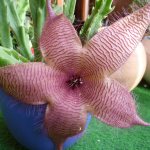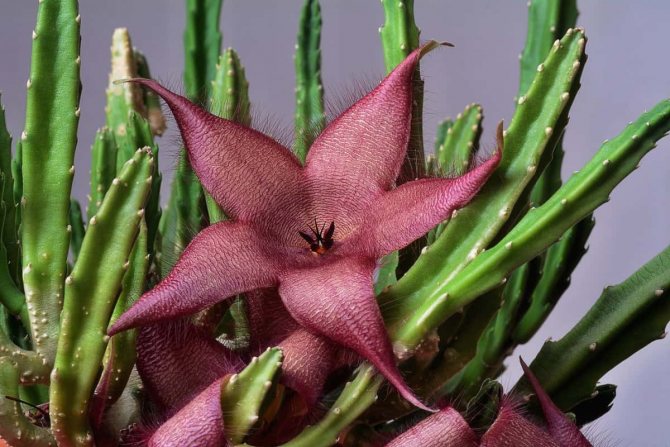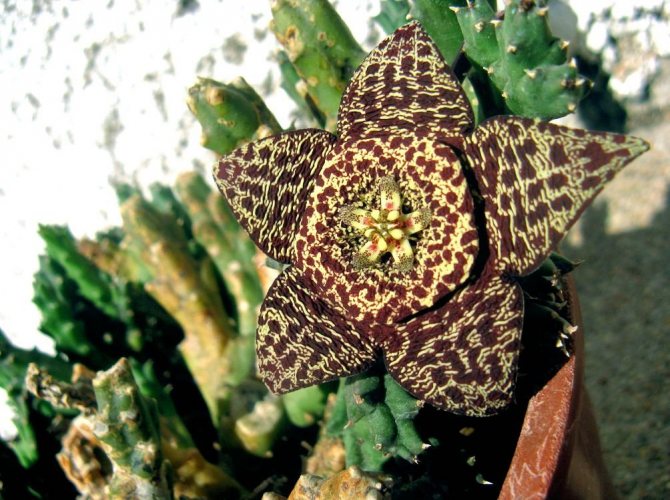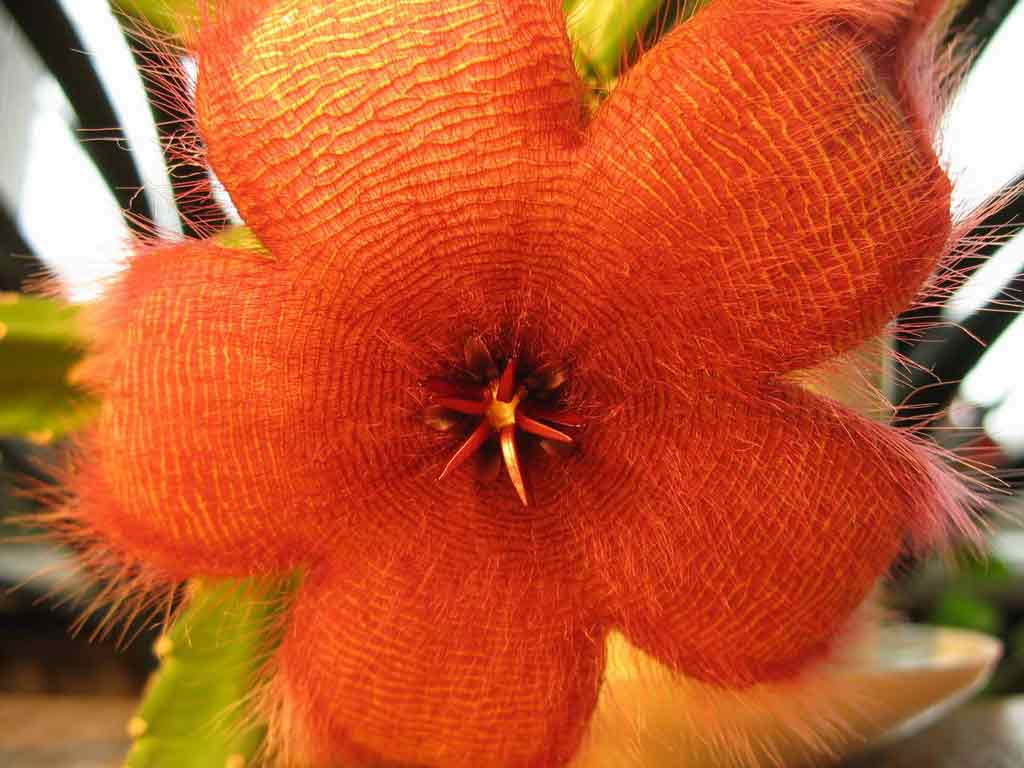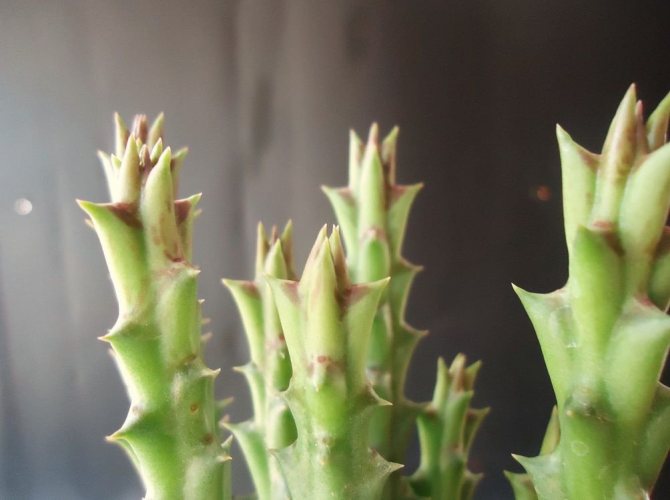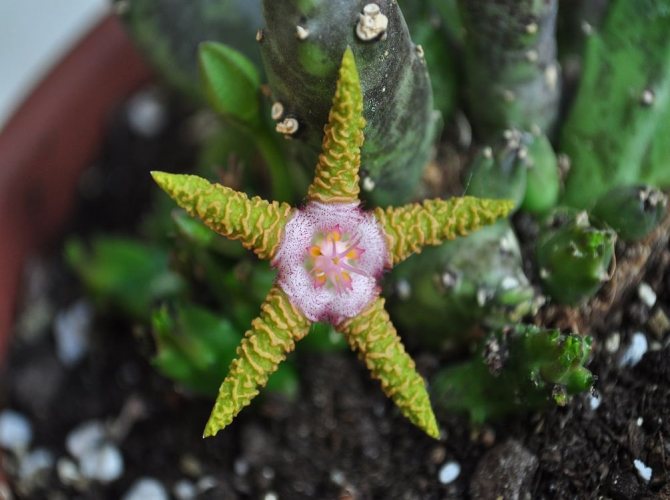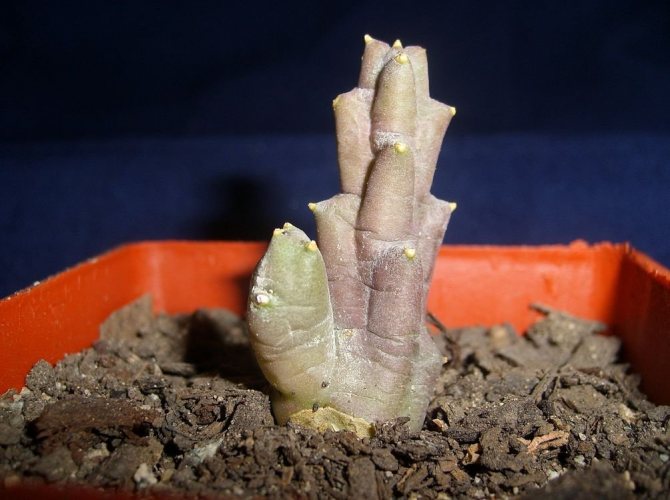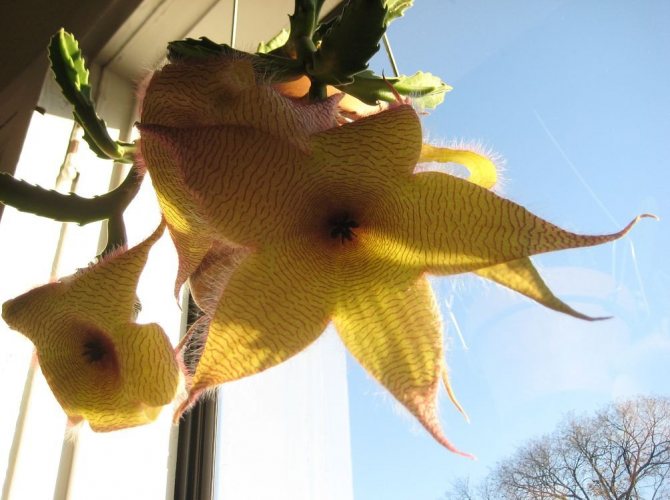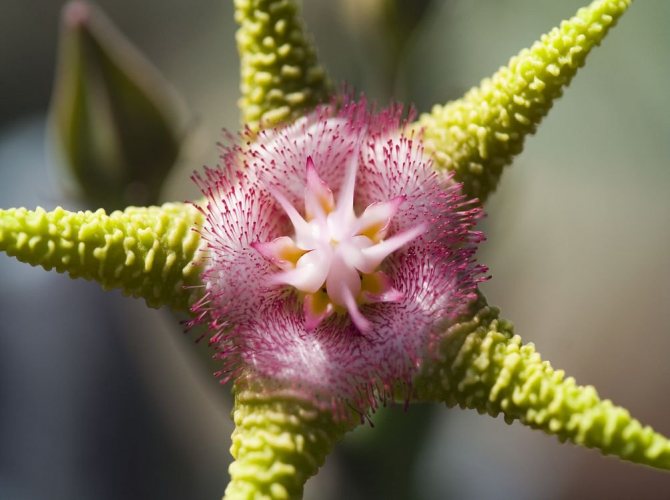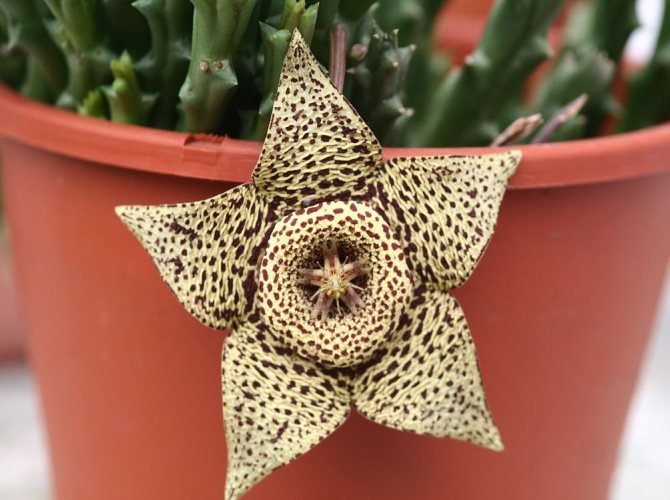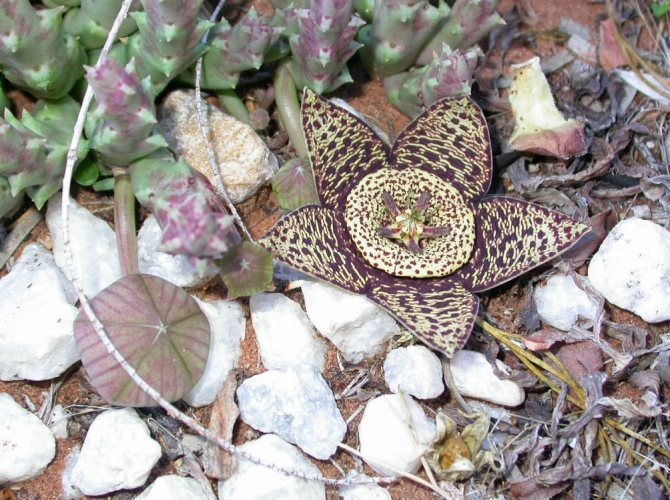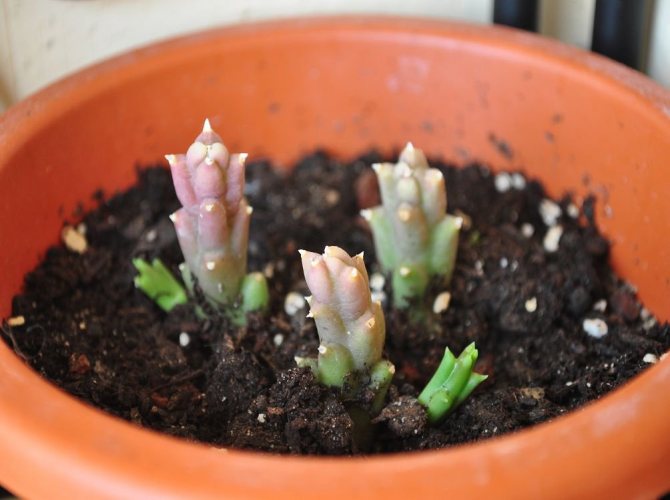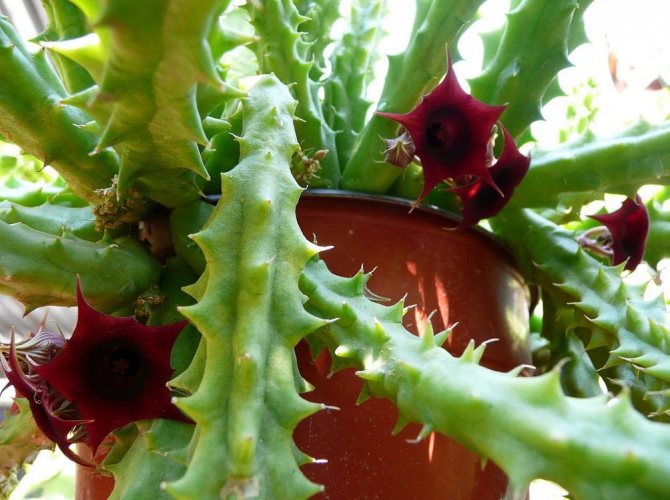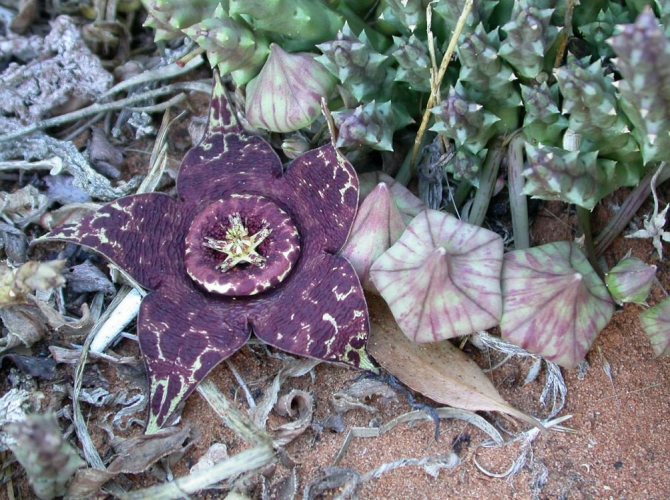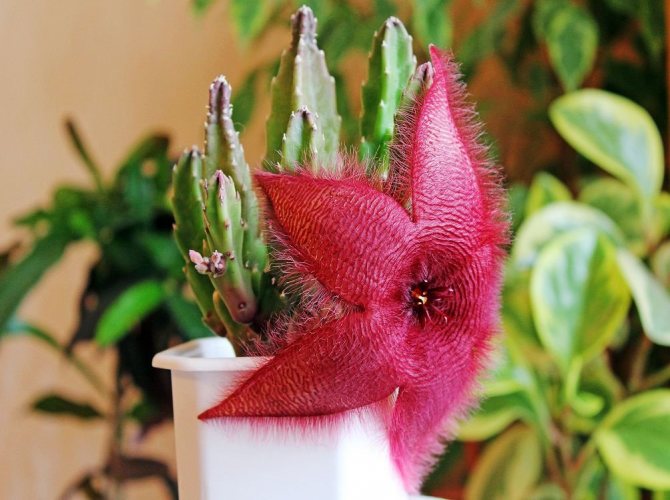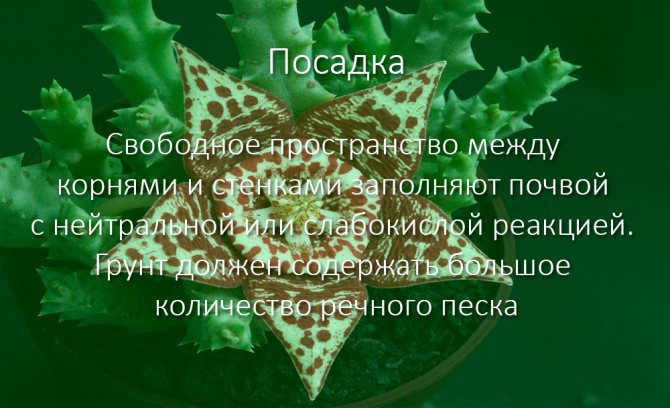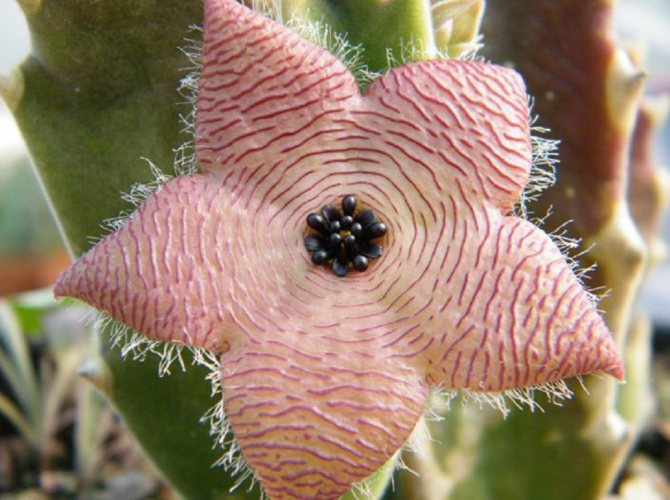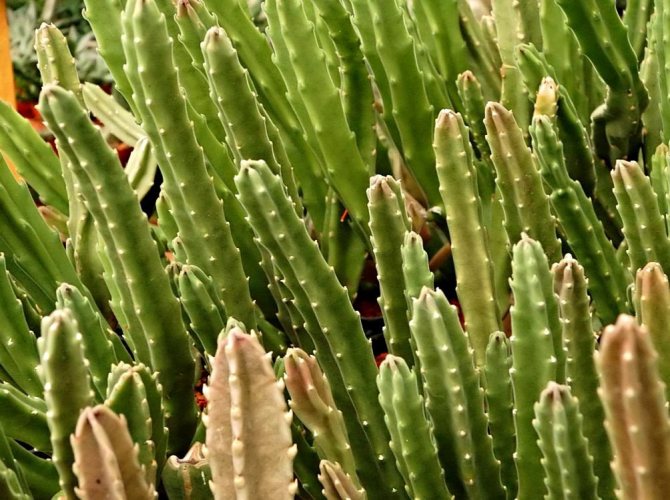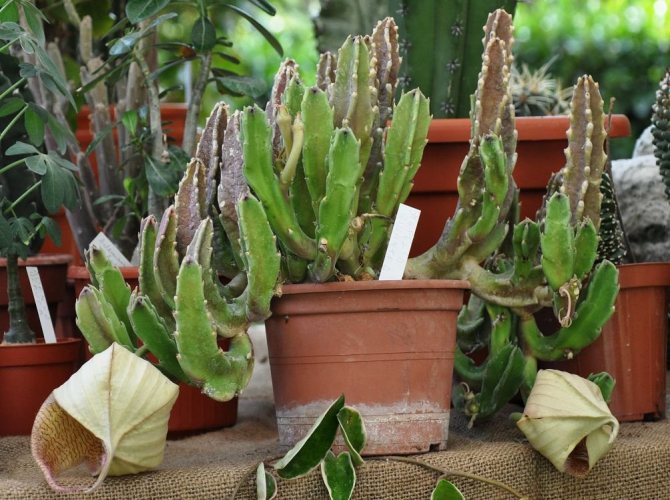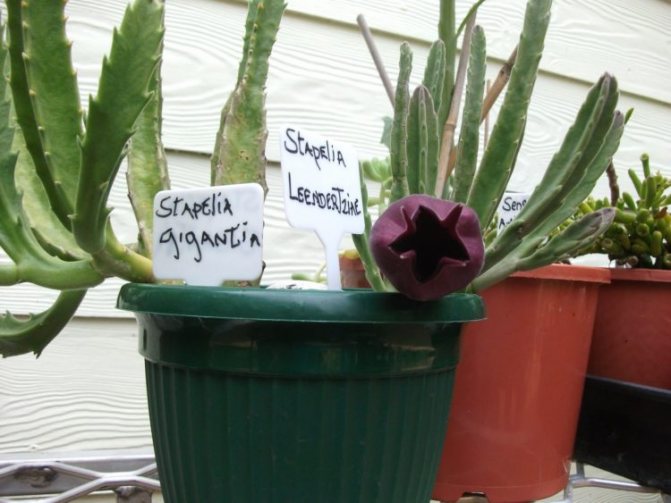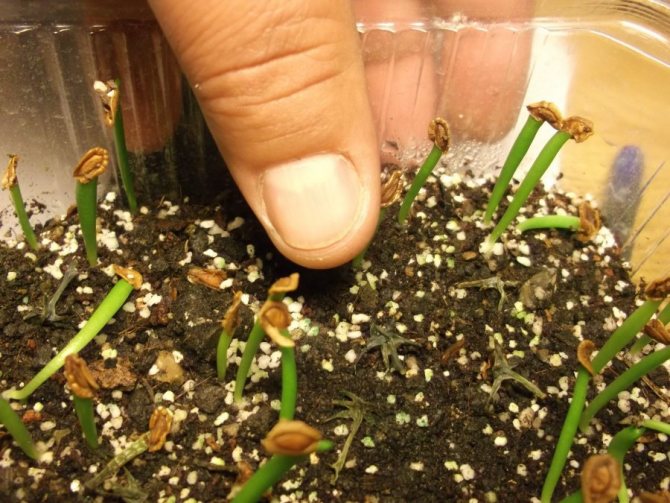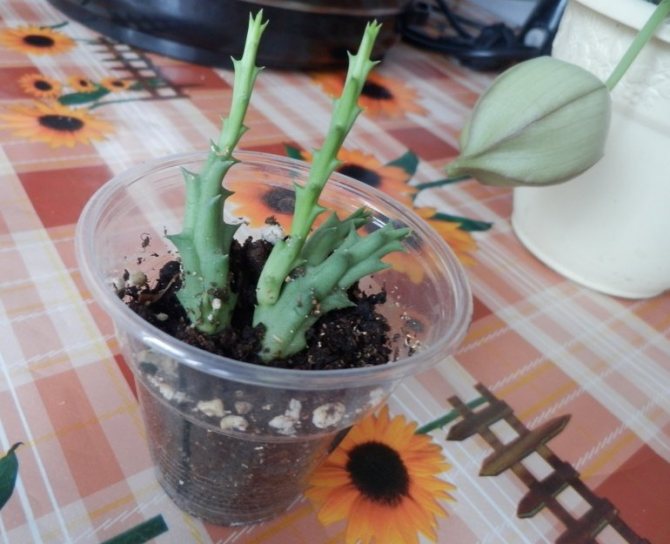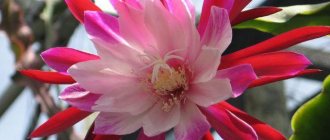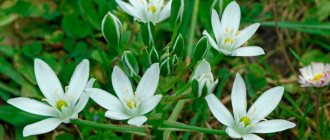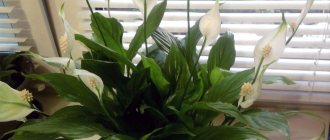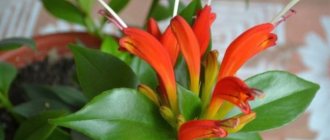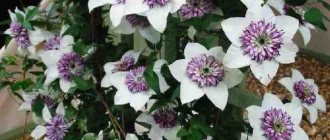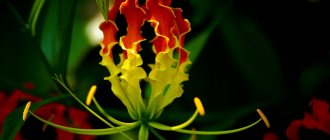The original indoor flower, the stapelia, attracts attention when it is time to bloom. Its large single flowers have a beautiful regular shape, peculiar shades and a characteristic aroma - the plant attracts flies to them.
He needs insects not for food, but for pollination and seed formation. In the regions of South Africa where the plant comes from, there are no bees or butterflies.
Botanical description
Stapelia is a succulent plant, reaching a height of 10-60 cm, with numerous juicy tetrahedral stems branching at the base, and the edges are decorated with large non-sharp teeth, thanks to which the flower is mistakenly called the stapelia cactus. The color of the shoots is green or bluish, under the influence of the bright sun they can acquire a red-violet hue, they have no leaves.
Flowers similar to starfish, pubescent, arranged in pairs or singly on bent pedicels, reaching a size of 5-30 cm, are often not on the tops, but at the base of the shoots. Depending on the species, the flowers are variegated or monochromatic with their own specific fetid aroma.
Description
The plant belongs to the Kutrovyh (Lastovnevyh) family, to the genus of succulents. The flowers are different, from small, up to 5 mm, to huge - 30 cm. In indoor slipways - 5-6 cm. The shape is a regular five-pointed star, reminiscent of a strongly opened bell.
Shades - fleshy burgundy, brown, beige with black stripes or specks. Some varieties have highly pubescent flowers.
Description of the general appearance: stems of calm shades of green, grayish-green, bluish, in the sun they can become violet-brownish. They are numerous, juicy, with jagged edges, can reach a length of 60 cm. There are no leaves.
How to care for stocks at home
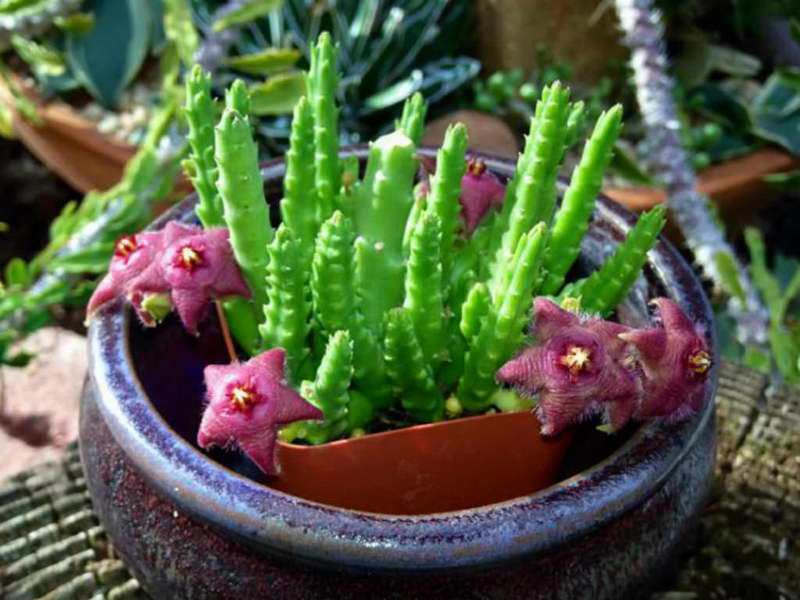
Stapelia flower photo stapelia how to make bloom
Air temperature and lighting
In the warm season, the temperature should be maintained at 22-26 ºC, in the summer it is recommended to take it out to the balcony or terrace. In autumn and spring, the plant rests; for wintering, the temperature does not exceed 15 ºC. To prevent the stems from stretching, not thinning, and flowering, a bright light is needed with the obligatory daily sunbathing, only on the hottest days it is worth protecting from the scorching midday sun, dangerous by burns. Choose a place for the flower on the eastern or western windowsills.
How to water
Like a succulent, the stock does not need abundant watering or spraying. An excess of moisture contributes to the appearance of a fungal infection that causes rotting: the leaves of the stapel become soft, turn yellow and die off. When planting, it is worth putting a drainage layer on the bottom of the pot - crushed expanded clay, ceramic shards or small pebbles to exclude stagnation of water in the roots. Watering scheme: February-September - no more than once a week, October-November - strictly once a month, December-January - do not water at all.
Top dressing
- In the summer, twice a month, you can feed with a mixture of fertilizer for cacti and succulents.
- Potash fertilizers in the fall will strengthen the immunity to diseases and prepare for the cold season.
- In winter, feeding is not required.
The basics of good care
Succulent is one of the unpretentious plants to care for.But to maintain the decorative qualities of the slipway when kept at home, a number of basic points should be observed.
Soil composition
The succulent plant is grown in containers with low wide sides. As a nutrient substrate, special soil mixtures are used, intended for cacti and succulents. They contain an increased concentration of sand, due to which they have a loose structure and are good at allowing moisture and air to pass through.
When self-manufacturing soil mixtures, sod land is used as the main component, which is mixed with sifted sand in a 2: 1 ratio. To minimize the risk of high soil moisture, crushed charcoal is added to the composition. Its percentage in the mixture should not exceed 8%.
The presence of coal in the composition is beneficial in the sense that it, like a sponge, absorbs excess moisture, and as the soil dries up, it gives it back.
Vermiculite and perlite also have a high coefficient of water absorption.
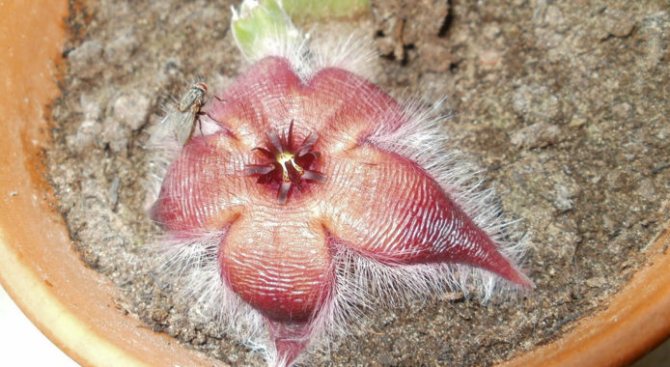

A succulent plant is afraid of transplants, so this procedure should be carried out only in exceptional cases. At a normal growth rate, the bushes are transplanted every 3-4 years. The procedure is performed in several stages:
- The bottom of the new tank is lined with a drainage layer of broken brick, fine gravel or expanded clay. The thickness of the drainage cushion should leave 1/3 of the soil composition.
- Half-fill the pot with a nutrient substrate.
- Trying not to damage the earthen ball, the plant is removed from the old container and placed in a new container. At the same stage, old, broken and shrinking shoots are removed.
- The roots of the bush are sprinkled with earth, leaving a rosette on the surface.
- The first watering is carried out 5-7 days after transplanting.
If desired, the transplant can be replaced with a more gentle procedure for rejuvenating an earthen coma. To do this, carefully remove the top layer of the earth, replacing it with a new nutrient substrate, and cut off the old lignified shoots.
During the growing season, the culture needs regular feeding. To do this, once every two weeks when watering, complex fertilizers are applied, intended for cacti and succulents. In the autumn-winter period, feeding is not carried out.
Light mode
There are no shade-loving plants among succulents. Stapelia is no exception. "Starfish", which naturally grows in open sunny areas, when cultivated as a home culture, needs a sufficient amount of sunlight. The only thing worth considering is that the starflower can get burns when placed in the sun. Lesions appear as a change in the shade of the stems. Therefore, when placed on a southern windowsill on sunny summer days from 11 to 15 o'clock, it is still recommended to shade the plant a little. For this purpose, it is convenient to use a voile, a rare net or a tulle curtain.
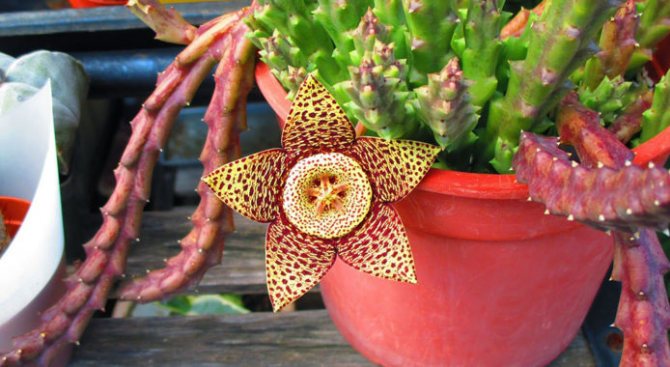

In winter, when new buds are laid, it is worth taking care of additional illumination of the succulent. The backlight should be organized so that the plant is evenly illuminated from all sides. Additional lighting with energy-saving fluorescent lamps will help to avoid stem pulling.
Humidity
Stapelia, like all succulents, exhibits a special relationship to moisture. It is able to do without watering for a long time because it accumulates large portions of moisture in the stems. Under natural conditions, during dry periods, the starflower does not die due to its ability to reduce transpiration. The effect is achieved due to the presence of wax deposits on the stems. Evaporation of moisture at night occurs through the stomata, located in the upper layers of the epidermis of the stems. During the day, the stomata are completely closed.
Watering the slipway, focusing on the temperature and humidity of the surrounding air. The main indicator is the degree of drying of the substrate in the pot.The soil should have time to completely dry out and, moreover, be in this state for about 5-7 days.
During periods of hot weather, the time between waterings is reduced. In dry summer, the soil should be in a dry state for only 2-3 days.
In the winter months, the plant can do without watering at all. But when kept at home, when the ambient temperature in winter does not fall below + 14 ° C, watering is carried out once a month.
Staple transplant
Since the plant grows rapidly in width, it is worth replanting young stocks annually in spring, older ones need to be transplanted once every 2-3 years, when transplanting, outdated shoots should be removed from the center of the flower, the flowering of which is unlikely. For perennial plants, it is enough to replace the top layer of soil with a new one once a year, just remove old shoots.
The root system is underdeveloped, so take a shallow pot, a third of which should be occupied by drainage laid on the bottom, the rest of the place is intended for a mixture of soil: 2 parts of turf + 1 part of coarse sand, or buy land for succulents and add charcoal. Before planting, the soil must be steamed; after transplanting, do not water the plant for a couple of days.
The video will tell you about the transplant of a diseased stock:
Is Stapelia poisonous?
The shoots of the staple contain milky juice, which is poisonous to insects. As for a person, he can only experience irritation of the mucous membranes.
It is better to keep the flower away from small children, as they have the ability to taste everything. If the baby managed to eat a piece of the plant, then his stomach will start to ache, nausea is possible. Parents should show their child to specialists as soon as possible. Adults should always wear gloves when working with the plant.
Why the staples do not bloom and how to make it bloom
Wintering in a warm place, lack of lighting, frequent abundant watering, inappropriate fertilizer composition, their excess or deficiency can cause the lack of flowering. What is needed for the stocks to bloom? Follow the rules of care carefully:
- in summer and spring you need to water when the earth dries out to the bottom of the pot, from October - watering once a month, December-January - do not water at all
- the rest period should take place only in cool conditions (no higher than 15 ºC)
- do not overuse fertilizers, especially nitrogen-containing ones
- the soil for the slipway must contain sand
- Adequate lighting is necessary (if there is a lack of light, the stems may turn yellow at the base - cut them off, they can be used as cuttings)
Adhering to these conditions, be sure to get a gorgeous flowering of the miraculous succulent.
Features of plant care
Lighting and temperature
Stapelia needs bright, but diffused light and daily sunbathing. Therefore, she feels most comfortable on the windowsills of the southern or eastern windows. However, one should not forget about shading the plant on especially hot days to avoid burns.
With a lack of light, the staples of the staples stretch, become thin. Such a plant, as a rule, does not bloom.
The amount of heat required for the slipway directly depends on the season. Wintering in a cool room promotes the formation of flower buds.
Temperature regime of flower maintenance - table
| Season | Life cycle | Temperature |
| Summer | Period of active development and flowering | + 22 ... + 28 ºС |
| Autumn, spring | Relaxation | +15 ºС |
| Winter | Dormant period | + 8 ... + 14 ºС |
Moisture level and watering
Staples develop and bloom best in a moderately humid climate. However, air humidity is not a decisive condition for the successful keeping of this plant. It perfectly tolerates dry air.
Stapelia does not require abundant watering and spraying even in the hot season. Excessive watering contributes to the occurrence of fungal infections and plant decay.
Specificity of seasonal watering of the stocks - table
| Season | Watering requirements |
| Summer | Moderate regular watering once a week. |
| Spring-autumn period (active vegetation) | As the soil dries up (no more than 1 time in 2 weeks). |
| Winter (rest) | Only after the earthen coma is completely dry (you can occasionally spray the topsoil from a spray bottle). |
The higher the temperature of the winter content, the more often watering and vice versa.
Top dressing
Stapels need feeding during the growing season and flowering. In spring and summer, the soil must be fertilized at intervals of 1 time in 2 weeks. Ready-made preparations for cacti or succulent plants are sold in specialized stores. Potash fertilizers enhance the "immunity" of the stocks and increase disease resistance. The most popular drugs are Agricola, Garden of Miracles, Uniflor. No feeding is required in autumn and winter.
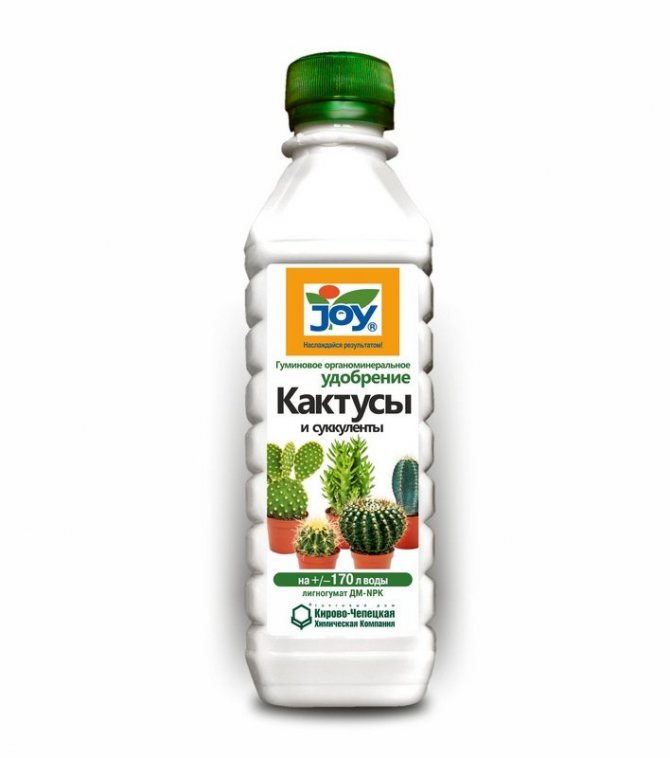

The introduction of top dressing will ensure the development and flowering of the stocks
"Fragrant" bloom of an exotic beauty
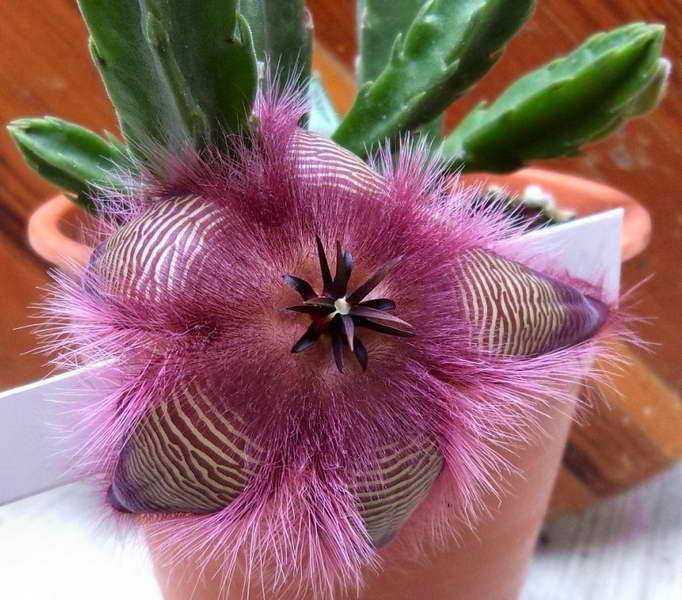

How the stapelia blooms photo
Your nose is sure to sense the beginning of the flowering of the stocks. The phenomenon of a repulsive odor is due to the fact that in the natural environment, pollinating insects are carrion flies that adore such odors. The only exception is the flavo-purpurea from Namibia, which exudes a wax aroma.
For the flowering period (about 2 weeks), you can take the plant out to the balcony so that the fetid smell stops haunting you. The charming beauty of flowering captivates flower growers, and they with particular zeal want to make the stocks bloom, because such a miracle is not often seen. By the way, flower growers often find out that the stocks stink like rotten meat by ransacking the entire apartment in search of the source of the stench. And only remembering that it is time to water the flower, they discover that it is he who is the culprit of the terrible aroma.
Possible difficulties
With proper care, the slipway does not suffer from plant diseases. If the soil is regularly poured, root rot may develop. In this case, it is almost impossible to save the mother plant. You need to have time to cut healthy cuttings and root them. Parasites almost never settle on stocks, so there is no need to worry about the safety of the flower.
When caring for a plant, you need to pay attention to its appearance. If the stems become pale and wrinkled, this indicates a bay. Elongated thin shoots indicate a lack of fertilizer and lighting. If the dormant period is improperly organized and there is a lack of lighting, flowering may not occur.
Pests and diseases of stocks
Problems in the care of the slipway appear from excess moisture - observe the correct watering regime and you will not be familiar with the troubles. Against spider mites, aphids and mealybugs, insecticides are used, sold in any flower shop. In general, living in Spartan conditions in a natural environment, the staples are extremely resistant to diseases and pests.
For any problems in care, you need to urgently respond, preventing the spread of the disease. Diseased and rotten shoots are removed, the plant is freed from the old soil and transplanted into fresh soil, after disinfecting the pot. After transplanting, the flower can be treated with the biofungicide phytosporin.
Dealing with problems
It is quite simple to look after the stocks. However, sometimes flower growers have problems, it is important to find out in time why they appear, and then overcome them.
Methods for eliminating care errors - table
| Problems | The reasons | Solutions |
| Lack of flowering |
|
|
| Yellowing shoots | Insufficient lighting. |
|
| The appearance of brown spots | Sunburst of stems. | Move the plant to a place inaccessible to direct sunlight. |
| The stems become soft | Drying out of the roots. | Provide sufficient watering |
| The appearance of diseases and pests | Stapelia are resistant to diseases and pests, most of all suffer from waterlogging in the cold season, which causes fungal diseases. |
|
Problems of growing stocks in the photo


Lack of light causes the stems to turn yellow
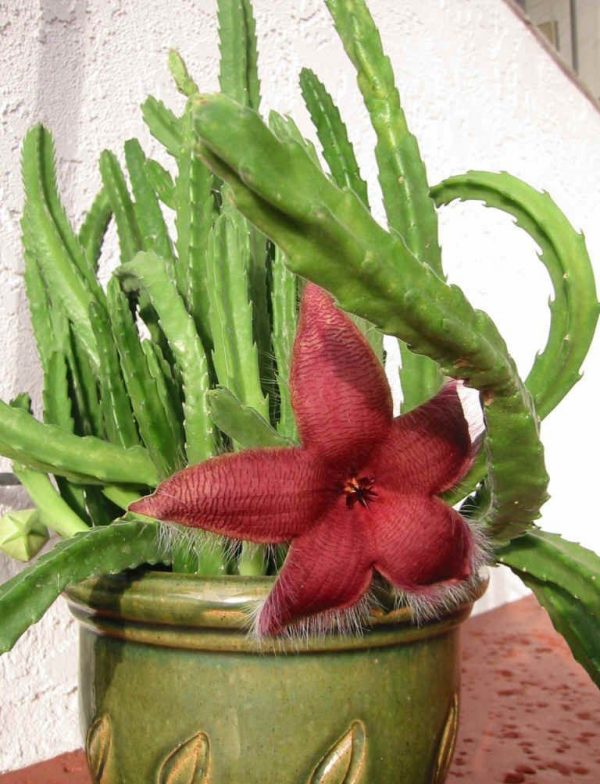

Drying of the roots is manifested in the softness of the stems
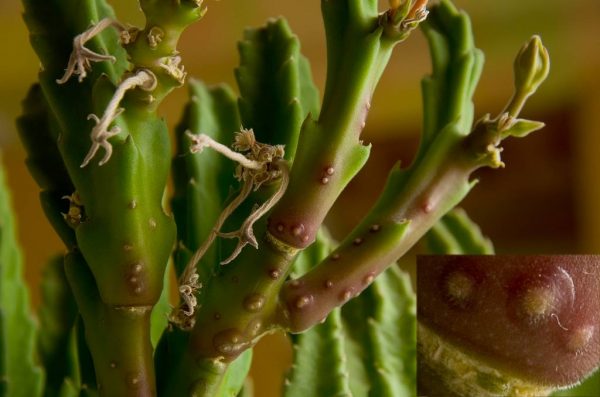

Brown spots - the effects of sunburn
If you are a fan of unusual plants and you are not afraid of the extraordinary smell of most types of stocks, then it will not be difficult to replenish your home collection with a new favorite. Just follow the simple rules for keeping the slipway and be amazed at its special beauty!
Reproduction of stocks by cuttings
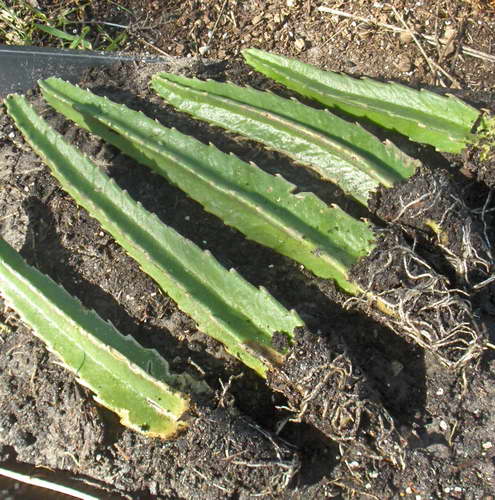

Staple cuttings with roots photo
- To plant a staple without roots directly into the ground, cut off the stalk using a sharp, sterile knife.
- Treat the place of the cut on the main plant and the cuttings with crushed activated carbon.
- Within a few hours, the cuttings are dried in a shady place, then planted in the ground of coarse sand with the addition of a small amount of crushed peat.
- After rooting, the plant is transplanted into soil from light turf, leafy soil and coarse sand in equal proportions, using a pot with a diameter of about 7-10 cm.
Features of this succulent
This is a guest from distant, hot Africa, and more specifically from the western and southern regions of the country.
"Freely" stocks grow under trees, near rivers and lakes, as well as on mountain slopes.
The plant blooms in summer, up to 15 days (or even longer), and it is very beautiful, several large single flowers bloom on one bush at once.
The only thing - they smell ... But what to embellish - they stink so that the pots had to be moved to an uninhabited room. As the mother-in-law said: "I searched for three days where my mouse died until I realized that it was a flowerpot." But from the windows of the veranda, they look great, all the neighbors are a feast for the eyes.
Although, of course, I will not say that the flower is not at all suitable for the living room: my husband, who does not distinguish smells well, did not notice anything strange at all. So here - who has what kind of nose.
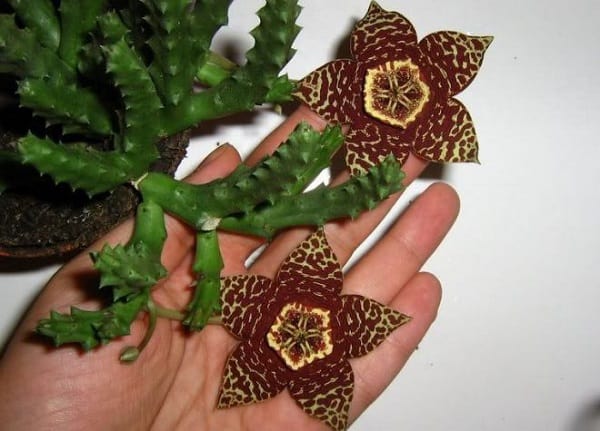

The rest of the year, the bush looks like a minimalist:
- from 10 to 50 (rarely 60) cm in height,
- juicy "plump" tetrahedral stems, decorated with whitish dots, vaguely resembling denticles (but not sharp),
- the color of the shoots of the plant can be green, less often grayish or with a lilac-red tint;
- the shade of flowers (as well as the smell, which in any case sensitive people will call far from perfume) is also different for each species, they are united only by the star-shaped shape and the presence of pubescence on the petals (in most species).
If you are interested in this amazing flower, I offer an equally interesting video. A man in high-speed shooting filmed the process of blooming and wilting of the stocks' flowers. Do not miss:
By the way! Fetid is not only a beautiful stapelia, a real orchid among cacti. What other stinkers grow in nature and in which countries they bloom, you will see in this video:
Growing stocks from seeds
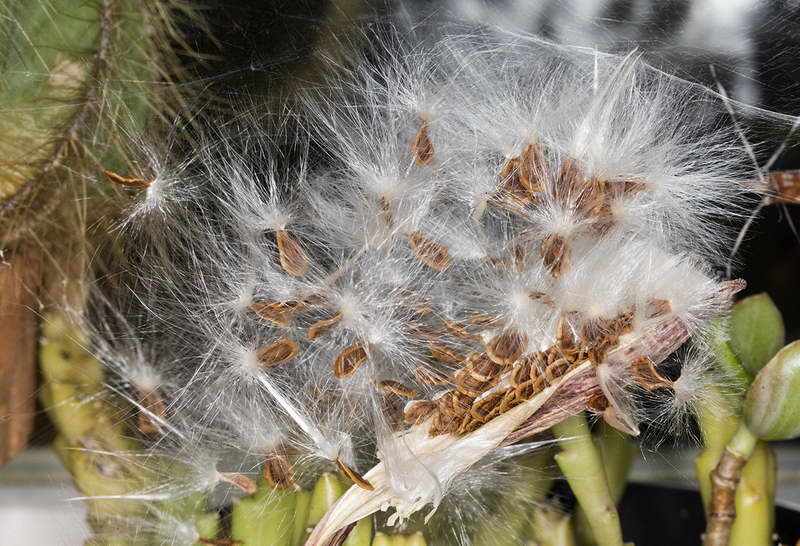

Stapella seeds photo What the fruits of stapelia look like
To collect the seeds, it is necessary to wait for the ripening of the fruit for more than a year. Seeds are sown in bowls in light sandy soil, waiting for shoots within 3-4 weeks. Stapelia grows slowly, so you need to be patient and try not to be zealous with watering: the ground should be only slightly damp, but not wet.
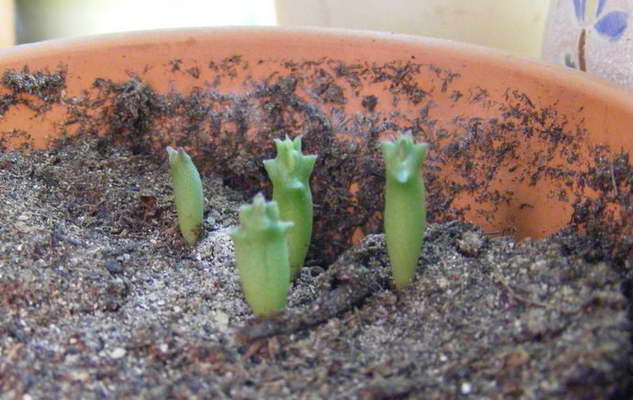

Shoots of stockpile 4 months old photo
The grown seedlings dive into separate cups, using the soil, as for cuttings. A year later, using the transfer method, they are transplanted into more spacious pots.
Culture propagation methods
The culture is propagated by dividing the rhizome during transplantation and by grafting the stems. Old shoots are used for cuttings. The stems are cut in half, forming cuttings 4-6 cm long. The planting material is pre-dried for 3-5 days.
Cuttings are rooted in moist sand. Pure water is not suitable for these spruces - the planting material will simply rot. Rooting of stem cuttings in wet sand usually takes 10-15 days. The main task at this stage is to maintain an optimal humidity regime.
The ideal breeding season is from early spring to late summer. The autumn-winter period is not suitable for the reason that in conditions of insufficient light and heat, the culture simply rots in damp soil.
Types of stocks with photos and descriptions
All varieties of stocks are unique in their own way - the flowering is fascinating, and it fascinates not only amateur flower growers. After flowering, it releases interesting fruits, somewhat similar to horns. Gradually they grow, lengthening, and after a long time they split in half. Seeds with fluff are collected inside, which, being released outside, become a fabulous decoration. In nature, the wind will immediately spread the seeds, but for some time we can admire the amazing phenomenon that happens every few years under favorable conditions.
Star-shaped stapelia Stapelia asterias Masson
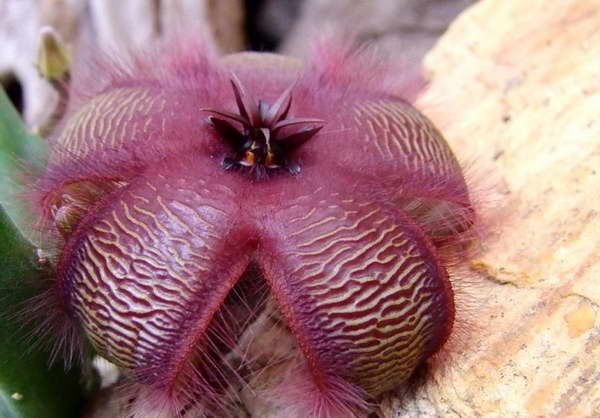

Star-shaped stapelia Stapelia asterias Masson photo
Reaches a height of up to 20 cm, reddish shoots with blunt edges are covered with small teeth. A long peduncle extending from the base of the shoot ends in a reddish-brown flower with thin yellow stripes, it is also covered with pinkish thick hairs. The glittering staple, the star-shaped variety, has no yellow stripes.
Giant stapelia Stapelia gigantea
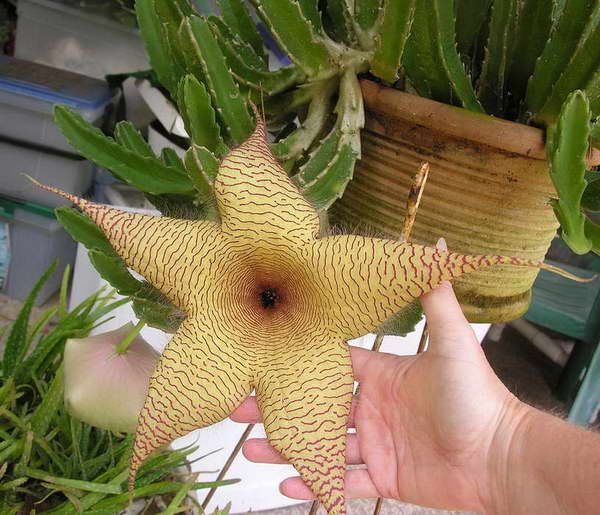

Stapelia giant Stapelia gigantea photo of flowering
Perennial succulent with strong erect shoots 20 cm high, 3 cm thick, blunt edges with rare small teeth. The flower is huge - about 35 cm in diameter, located on a long pedicel, the petals are triangular, elongated-pointed, slightly bent. Light yellow flower, covered with red thick hairs, the edges are decorated with long white hairs. Feature - the aroma of this species is weak.
Stapelia variegated or variegated Stapelia variegata
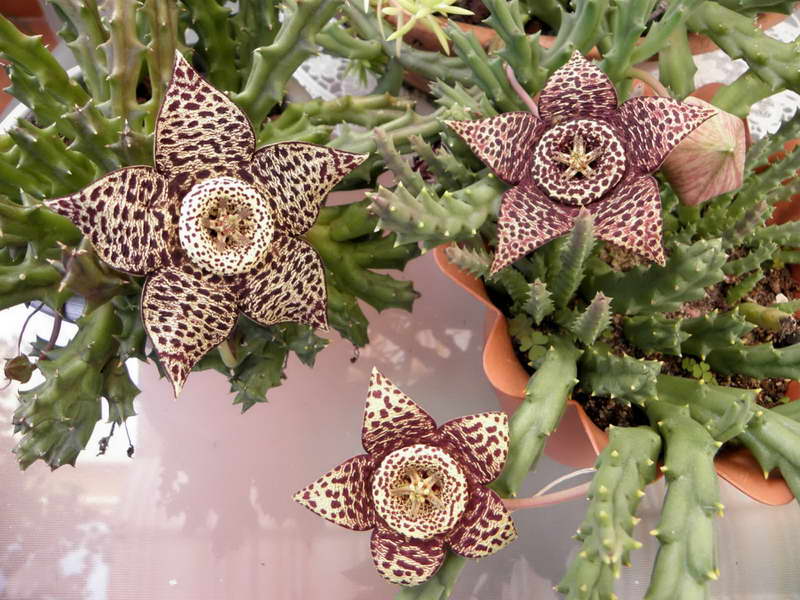

Stapelia variegated or variegated Stapelia variegata photo of flowering
Only 10 cm high, the shoots are green, sometimes reddish, the edges are obtuse, covered with teeth. Flowers - one and up to 5 pcs. - located at the base of the shoots. The yellow ovoid-pointed petals are smooth on the outside, wrinkled inside, painted with brown stripes or asymmetric spots, blooms in summer.
Stapelia glanduliflora or large-flowered grandiflora Stapelia glanduliflora Masson
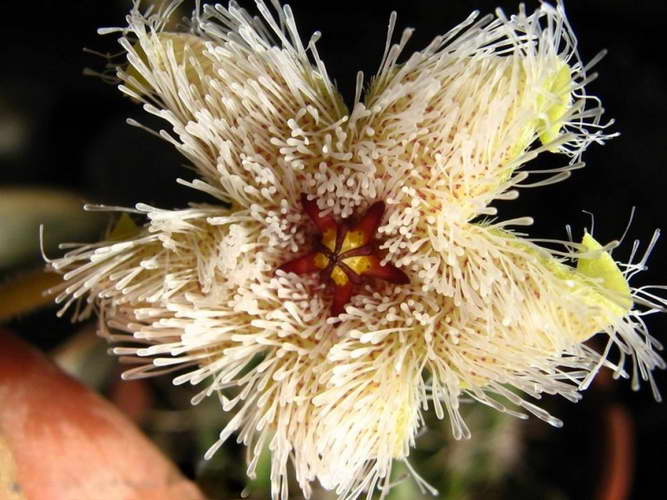

Stapelia grandiflora Stapelia glanduliflora Masson photo of flowering
Up to 15 cm in height, straight shoots about 3 cm in thickness, pterygoid edges with small sparse denticles. On long pedicels there are 1-3 greenish-yellow flowers, decorated with light pink stripes and spots, the edges are slightly bent, numerous colorless hairs completely cover the flower.
Stapelia golden purple Stapelia flavopurpurea
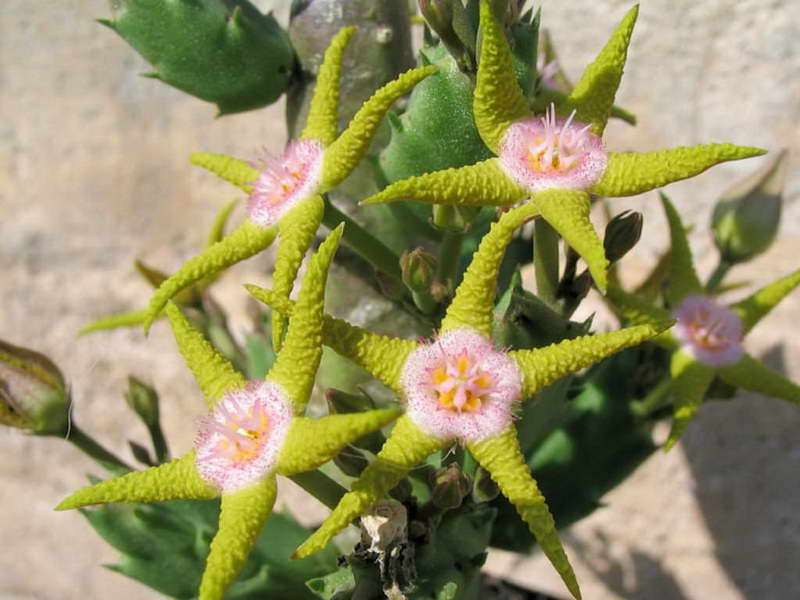

Stapelia golden-purple Stapelia flavopurpurea photo of flowering
Reaches a height of 10 cm, with green, rarely purple shoots, blunt edges, covered with teeth. One or three flowers are located at the tops of the shoots, the petals are triangular, ovoid, the edges are pointed, strongly curved. Outside they are painted in a light yellow color, naked and smooth, inside - golden yellow, occasionally burgundy, covered with wrinkles, have a pleasant wax aroma.
Plant characteristic
Stapelia belongs to the genus of perennial succulents and the Kutrov family. In nature, it is found in the semi-arid regions of South and Southwest Africa. The succulent has an interesting structure. Numerous fleshy stems branching from the center of the rosette have a tetrahedral shape. Each facet is framed by thin protruding whitish teeth. "Coral reef" annually increases the number of spreading wriggling stems, forming original "bundles" of a dozen shoots.
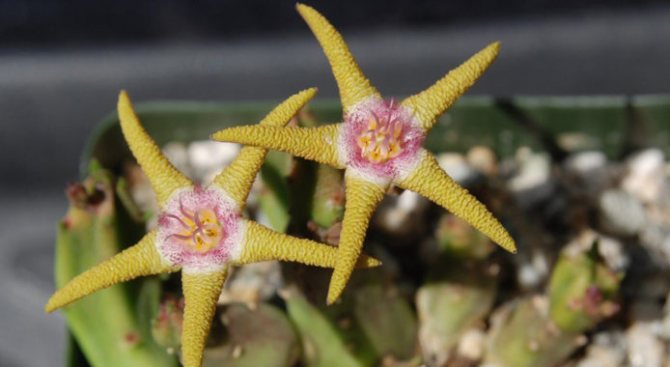

The color of the stems themselves, depending on the lighting, can include shades of gray-green, emerald and even reddish-purple. Leaves are completely absent from plants.
The main decoration of the stocks is a flower. The buds, which form at the base of young shoots, are planted on graceful bent pedicels. Flowers, the diameter of which sometimes reaches 30 mm, can be either single or paired. The rim of the buds has the shape of a five-pointed star, in the center of which an openwork crown sits above the petals. The petals ending towards the top create that inimitable effect, giving the flower the perfect star shape. The buds open slowly. The start of the mesmerizing process will be marked by a loud bang. The color palette of the petals is no less impressive. Cherry and brown spots and touches on a light background, combined with an unusual texture, create the illusion of the color of outlandish mollusks and luxurious fur of fabulous animals.
With all the advantages of an amazingly beautiful flower, the stapelia has a single, but significant drawback - a disgusting smell. During the flowering period, it spreads a putrid smell in the area, very reminiscent of the stench emanating from spoiled meat. This is how the plant attracts pollinating insects. For this reason, the famous German thinker and philosopher Goethe called the stocks the most beautiful, but at the same time, monstrous flower in the world.
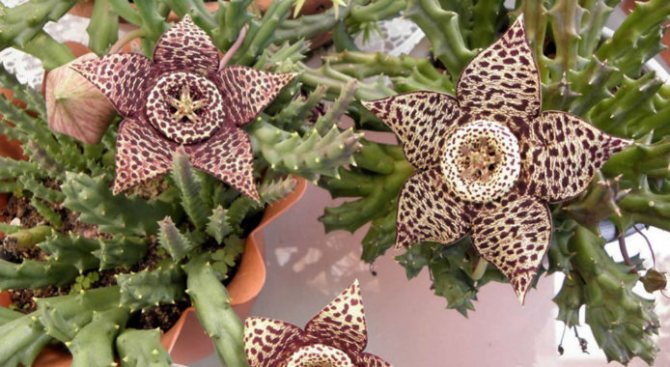

The maximum height of low-growing plants growing in natural conditions does not exceed 40-50 cm. Staples are grown as a room culture, the height of which is 10-20 cm.
Staple irrigation and air humidity
It is necessary to water the starflower carefully, allowing the soil to dry out between these procedures in the upper layer. When watering, you need to be careful not to soak the bases of the shoots and not to spray drops on the plant itself. During the dormant period, during the cool content, the stocks are watered with a minimum amount of water, just not allowing the stems to dry out, wrinkle, and lose turgor. You always need to be guided by the temperature indicators and the rate of soil drying.
There is no need to increase the humidity of the air for this succulent, the stapelia is not afraid of a very dry environment both in summer and in winter.
Varieties
Currently, the following types of plants are very popular among indoor plant lovers:
- stapelia Giant
A distinctive feature of this variety are flowers, reaching a diameter of 30 centimeters. On the plant, 1-2 flowers are formed, colored yellow. On the surface of the petals are thin red or crimson hairs... The petals are pointed and slightly curved. Flower corollas are at a distance from each other... This allows you to admire the beauty of each flower separately. Flowers of this stapelia variety have a strong putrid odor;
- Stapelia Grandiflora
The shoots of stapelia Grandiflora have light pubescence and large interesting flowers. The corolla of the flower reaches a length of 15-20 centimeters. The color is quite complex: the lower part is blue or greenish, and the upper part is bright red with stripes. The petals are bent slightly upward. The flower has a smell of spoiled meat or fish characteristic of the stocks;
- stapelia Golden purple
In natural conditions, it grows on rocky soil. Differs in small size. The shoot height is no more than 10 centimeters.The stems are colored green, in some specimens they are brown or dark red.
Flowers are located at the top of young shoots. The corolla has a dissected surface and pointed triangular petals, which are strongly curved at the edges. The back of the petals is smooth, and the top may have a wrinkled surface. The color of the flowers is quite varied - from golden to purple;
- Stapelia Variegated
This is the most common plant species. Stapelia variegated is a low bush. Shoots are colored green or slightly reddish. At the same time, up to five flowers can develop on a plant, located near the base of the shoot. The flower reaches a diameter of 8 centimeters. The petals are triangular, ovoid, slightly curving in shape. Outside, they are leathery and slightly wrinkled, painted in a bright yellow color. There are brown spots and stripes on the surface. Flower color may vary. Stapelia variegated belongs to the most unpretentious plants in home care;
- stapelia large-flowered
This plant variety is striking in its extraordinary beauty. Stapelia Large-flowered, with proper care, forms lush thickets. The stems have a velvety surface and sparse denticles. Under the right light, the shoots turn purple. Flowers reach 20 centimeters in diameter. They have a densely pubescent surface. The elongated petals are colored blue at the bottom and purple at the top. A feature of the large-flowered staple is the absence of an unpleasant smell.
Popular varieties
Today the genus of stocks consists of a little more than fifty varieties. Most of them are suitable for growing at home, have a high decorative effect and many species are quite unpretentious.
It is interesting! In Sweden, the city of Uppsala has a large European center for stockpile lovers. It is called Asclepias.
Among the abundance of species, you can choose the most favorite succulents:
- Stapelia large-flowered
A perennial succulent plant with tetrahedral stems that actively branch at the base. Blooms in the summer with "starfish", 15–20 cm in diameter, burgundy or purple shade, pubescent silvery villi. The aroma is weak. The second name of the species is grandiflora staple.
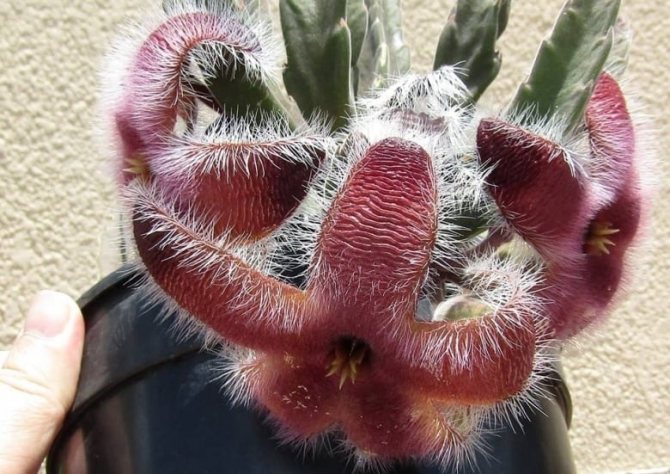

Stapelia large-flowered
- Giant
It differs from other representatives by its massiveness, large, strong shoots up to 20 cm long and up to 3 cm in diameter, with vertical grooves. And also - the largest flowers, light, cream tones with an abundance of contrasting burgundy strokes. The petals at the tips taper and twist in a spiral. The giant stapelia is rather "fragrant", flowering is accompanied by the "smell" of rotten meat.


Giant stapelia
- Stapelia variegated
It is also called variegated stocks, varying, it is also variegata (variegata). A succulent plant with rounded, rich green stems, the ribs of which are smoothed, covered with hooked teeth.
Blossoms in summer motley staples with cream, yellow flowers, with triangular petals, the surface of which is covered with burgundy or brown spots. The rim is flattened, in the middle there is a protruding ring. It smells intense, offensive.
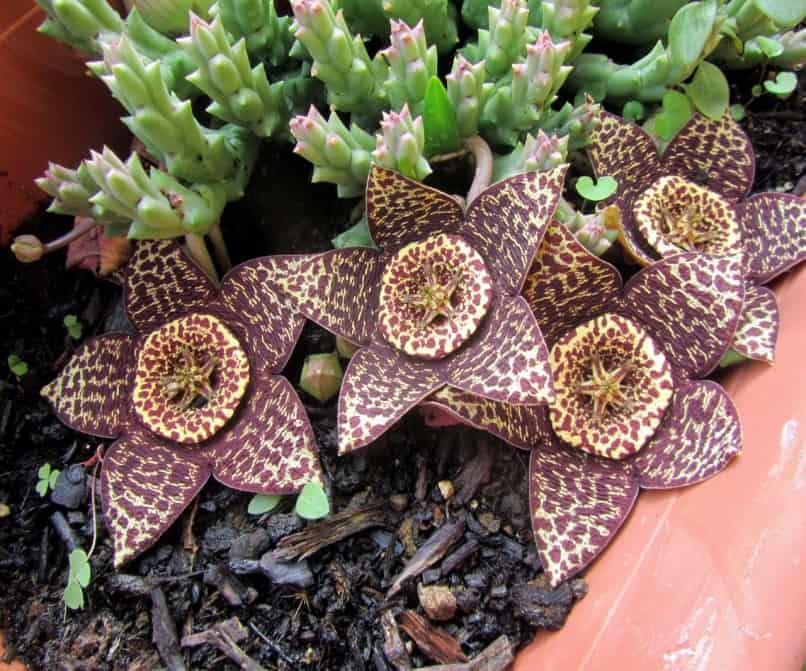

Stapelia variegated
- Star-shaped (asterias)
This plant has tetrahedral shoots, the length of which does not exceed 20 cm. They are covered with a smooth greenish skin with purple stains of varying intensity.
Flowers are located at the base of the shoots on thin, long pedicels - singly or in groups of 2-3 pieces. The petals have a glossy surface with tubercles. Coloring in warm colors - red or yellowish. The lateral edges are covered with villi.
There is a kind of shiny star-shaped staple - stapelia asterias masson var lucida, which has a solid color, without stripes.
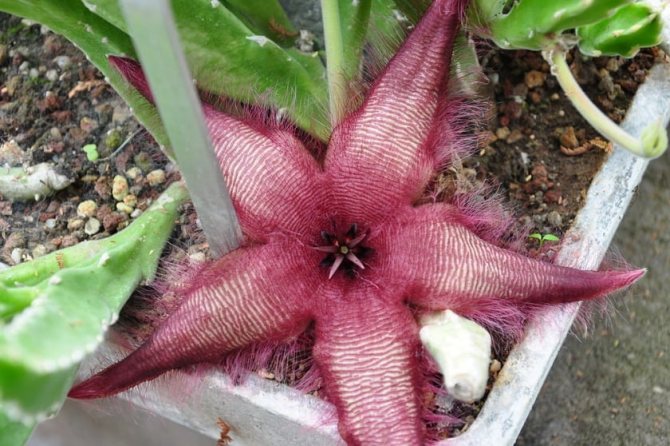

Star-shaped stapelia
These are far from all the beauties-stocks that flaunt on the windowsills of flower growers. And as a rule, having got hold of one exotic plant, amateurs and professionals do not stop there, replenishing an exotic collection. But in order for this succulent stock to grow, and most importantly, to bloom regularly, its needs should be taken into account. Moreover, some varieties are quite capricious.
Reproduction
We have already said above that at Stapelia, after flowering, seeds ripen in seed pods for a year. Experimenting enthusiasts can grow new plants from seeds. To do this, they are sown in a container with sandy-peat soil. The seeds are lightly pressed into the ground, sprinkled with a thin layer of sand. Cover with glass, film from above. The soil is moistened with a spray bottle. Seedlings appear almost a month after planting.
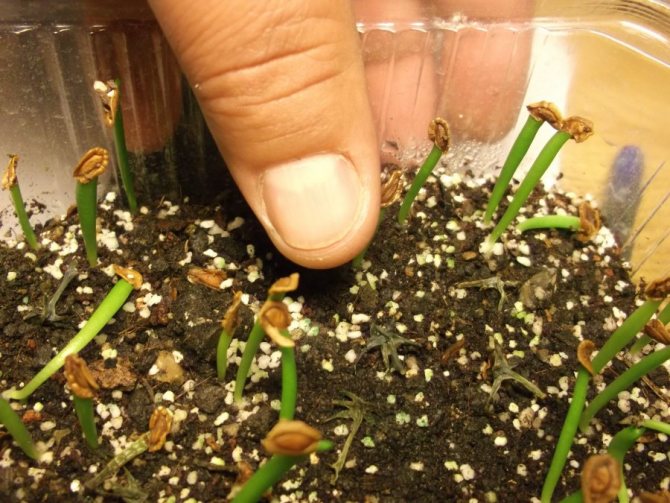

Sprouted Stapelia Seeds
When they reach a height of one and a half centimeters, they are seated in separate small pots with a dive. The next transplant is carried out in a year. It should be noted that young plants grown from seeds do not always inherit the specific characteristics of their "parents".
It might be interesting: Pachypodium - home care
An easier way to get a new plant is by cuttings. Usually cuttings are obtained in the spring, when the adult plant is transplanted into a new pot. A small five-centimeter lateral shoot is cut off. The place of the cut on the cuttings and the parent plant is sprinkled with crushed activated carbon. The cutting must be dried within 24 hours.
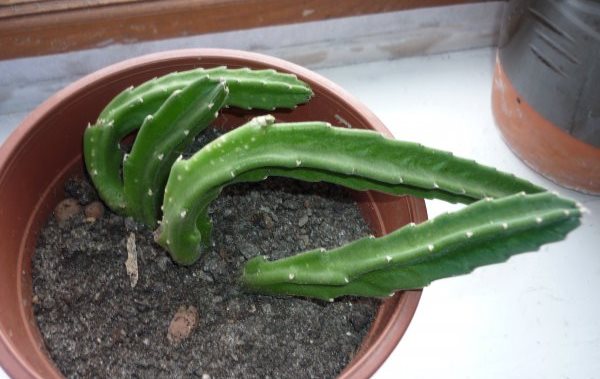

Planted cuttings of Stapelia
Then they are planted in a mixture of sand and peat, slightly deepening the cutting. The first week, the soil is slightly moistened with a spray bottle. The cuttings of the Stapelia must be propped up until they are fully rooted. After rooting, the young plant is planted in a mixture for succulents. The grafting method is used in the following cases:
- to grow a new plant;
- preserve the variety in case of disease of an adult plant.
Temperature regime for the slipway and airing
Stapels grow well in indoor conditions. For them, moderate temperatures of about 20 degrees Celsius are also suitable, and a warmer environment from 22 to 26 degrees. Extreme heat is best avoided, but higher temperatures usually only affect the frequency of watering. For the rest period, the stocks should be kept cool. Optimum temperatures - around 15 degrees - allow the plant to prepare for flowering. The minimum allowable temperature is 12 degrees. In such conditions, the stocks should be from November to March. The transition from warm to cool content and vice versa for the slipway should be as smooth as possible, the plant is prepared for a dormant period slowly, gradually lowering the temperature.
Stapelia, unlike many other indoor succulents, love frequent airing. In summer, the slipways can even be taken out into the open air, protected from direct sunlight. The plant is not afraid of drafts, but it is better to protect it from hypothermia.
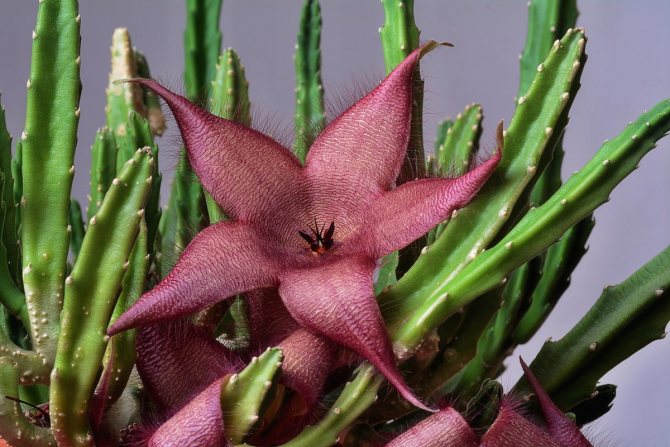

Giant stapelia (Stapelia gigantea)
Photo
For more photos of the slipway, see below:
How to water
Watering should be approached with special care. Very often, the owners of the slipway make the mistake of oversaturation of the plant with moisture. For this reason, root rot appears, which is quite difficult to get rid of.
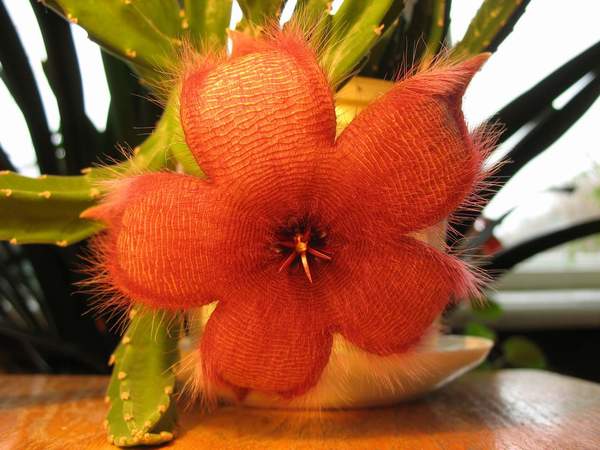

Watering the crop should be rarely, but abundantly, as the soil dries out. Moisture for saturation of the flower should be at room temperature. In the cold season, watering is reduced to once a month.
Top dressing
Home care involves the timely application of fertilizers:
- in the summer they enrich the soil with special agents for cacti and succulents. Frequency - every 15 days;
- in August and September, the use of drugs with a high potassium content is required. They strengthen the immunity of the flower and enhance its ability to resist diseases;
- in winter there is no need for feeding.
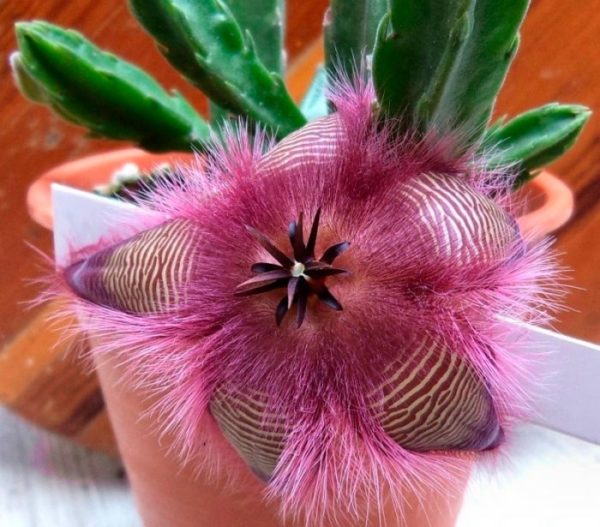

Note! The preparations "Agricola", "Garden of Miracles", "Uniflor" have proven themselves well. They contain an optimal concentration of nutrients, due to which the succulent is more tolerant of external unfavorable factors, intensively grows and develops.
Content
- Listen to the article
- Description
- Caring for stocks at home How to care
- Staple transplant
- Bloom
- Pests and diseases of stocks
- Stapelia does not bloom
- Cuttings
- Star-shaped stapelia (Stapelia asterias)
Indoor plant species
There are about 100 species of stocks in the wild. Of course, only a couple of percent of these flowers have penetrated our windowsills - but what!
Stapelia variegated (variegated, varying)
It is such a plant that has taken root with us.
The edges on its green (less often reddish) branches are dull, the bush grows up to 10 cm.
The flowers resemble the order: five distinct pointed petals, leopard print. Outside, their petals are delicate and smooth, and on the inside they are covered with grooves and wrinkles.
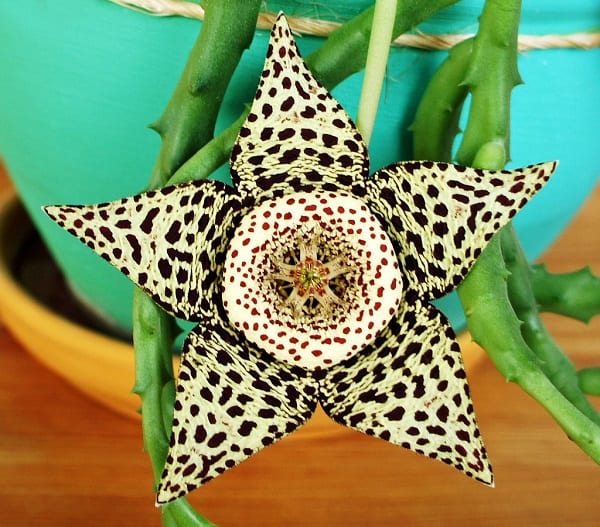

Large-flowered (grandiflora)
Thick twigs of this type have 4 edges with rare teeth curved to the side.
The tips of large burgundy flowers are long and sharp, their outer side is bluish in color. The petals have an edge, which is traditional for most stocks.
Many people compare the "aroma" of this type with spoiled meat.
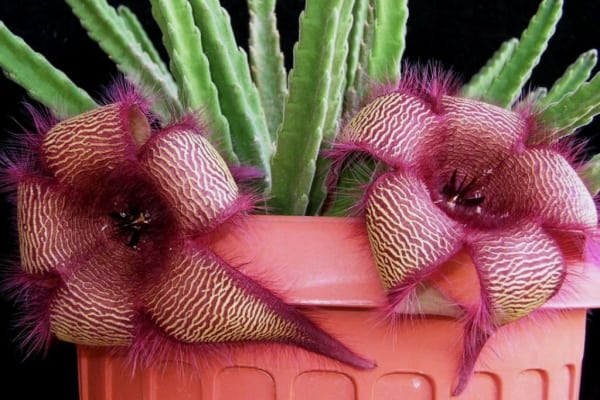

Giant (gigantea)
A green plant with faceted branches covered with mild teeth. It grows up to 20 cm.
The species got its name because of the flowers, the diameter of which reaches 35 cm. Their three to five petals are slightly bent back. The color of the petals is dirty yellow, and the petal itself is covered with red villi.
Nice bonus: this is the most smelly kind.
Glandular
A low (up to 15 cm) bush consists of faceted shoots decorated with soft "teeth".
The flowers bloom on it are relatively small. On one peduncle - several pieces. Their greenish lemon petals are covered with a noticeable white pile from the inside. In addition to it, there may be spots and stripes on the petal.
Another "almost fragrant" look.
The bush is small, of purple or green twigs.
Flowers are similar to starfish: their sharp petals are elongated and voluminous, covered with numerous bulges and wrinkles. They can be greenish, yellowish, with a brown or burgundy tint, and always with a contrasting (white-pink) center.
Stapelia description
The stapelia flower has wide fleshy shoots - stems. Twisted shoots of bright green color, sometimes decorated with small yellow or pink spots and whitish pollination. They have from four to six faces, between which there are small protrusions.
The culture usually blooms in summer. First, egg-shaped buds are formed, which are located in the lower part of the shoot. Each inflorescence has a long peduncle. The blossoming flowers take on the shape of a star with thick petals, the bases of which grow together in the center. The entire surface of the flower is strewn with light villi. The colors are varied, it all depends on the type of plant.
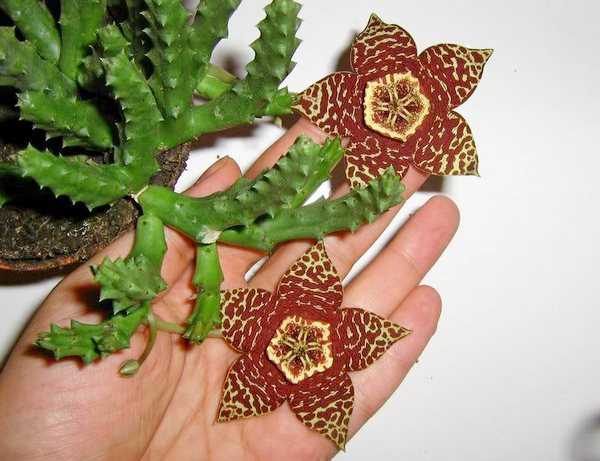

Lighting and placement of the slipway
Stapelia are sun-loving exotics, but in summer direct sunlight will lead to a loss of decorative shoots, the appearance of dry spots. Despite the status of the African exotic, they are found in nature in rather secluded places, and the lighting for them is selected bright, but diffused. In autumn and winter, direct sunlight is not contraindicated for the stocks, it is better to move the plant to the brightest windows in the house. With the transition from winter to spring to an increase in illumination, it is better to accustom the slipway gradually.
Stapels feel comfortable only on sunny windowsills. The ideal place for this succulent will be the southern window sills with diffusing screens or the first row on the western and eastern window sills. When placing stocks, it is worth considering the presence of an unpleasant odor in some species, which requires placement in ventilated areas away from living rooms.
Flowering stocks
The flowering period of the plant runs from late spring to late summer.
Flowers grow at the base of the shoots, 1 or several pieces. The flowers are beige with reddish veins, on long legs, pubescent. A cup of 5 leaves of a built-up shape. The petals are fleshy, fluffy or bare. The flowers have a pungent unpleasant odor that attracts insects.
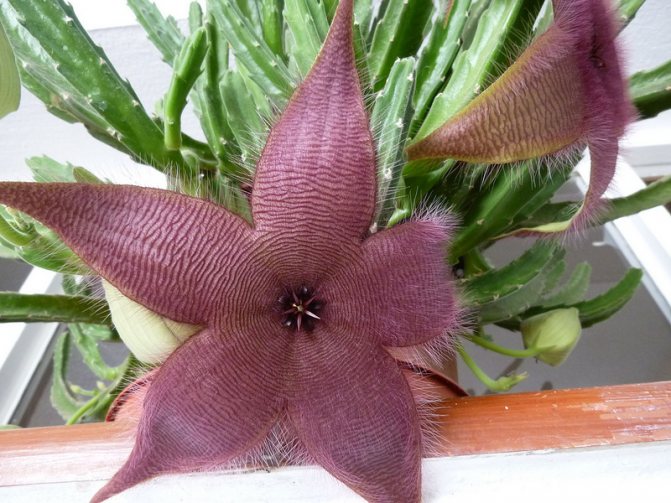

It looks like a blooming stapelia
It is better to remove wilted flowers to give the stocks strength for new buds.
See the video for examples of flowering:

